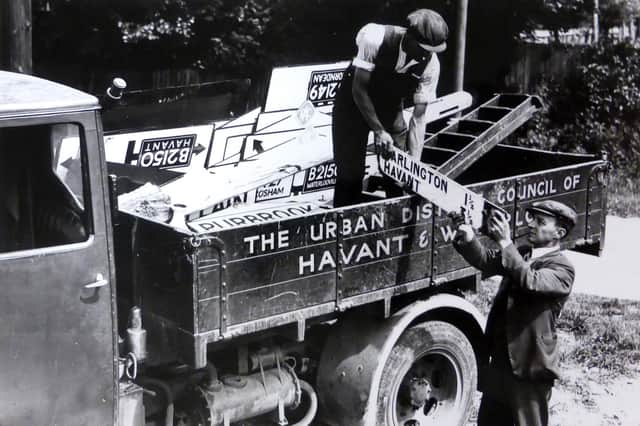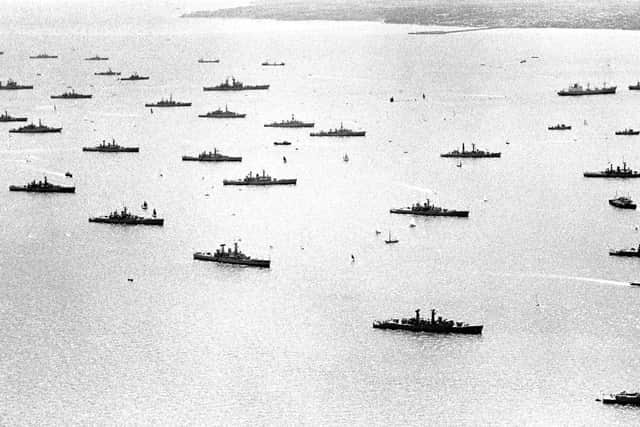Portsmouth street signs come down in bid to baffle German invaders | Nostalgia


The threat of German parachutists landing was taken very seriously by the authorities.
Of course, if any had landed, they would have wanted to know where they were so all street signs were removed and put into storage for the rest of the war.
Advertisement
Hide AdAdvertisement
Hide AdWhen I was writing my book The Naval Camps of Bedhampton, Havant and Leigh Park I interviewed Len Burford, from Redditch, Worcestershire, who told me of the time the threat was taken very seriously.


He was at Stockheath Camp, now part of the Leigh Park estate, in March 1942.
The camp had a ‘flying column’ on standby in case of invasion. The column comprised 100 fully armed ratings with an officer and petty officer in charge.
Len told me: ‘On the day before I was to leave the camp there was an anti-invasion exercise.
Advertisement
Hide AdAdvertisement
Hide Ad‘The column was to assist the Home Guard to defend the area from invasion. The whole camp was put on stand-to for the following 24 hours.
'I was on guard when at about 7pm the column returned at the double. Instead of dispersing as usual they were marched with full packs to some spare Nissen huts near the main gate.
‘Several minutes later an officer approached and doubled the guard and everyone was issued with rifles plus ammunition which was kept in reserve.
‘All were told to load their rifles and remain vigilant throughout the night. If anyone approached who did not know the password then we were to open fire. We were told that parachutists had been seen landing and under these circumstances we on guard should not expect to be relieved for some hours.
Advertisement
Hide AdAdvertisement
Hide Ad‘A petty officer had visited cottages and farms in the area and told the occupants to remain indoors and not to answer their doors to anyone.
‘Before he departed he told patrols to be extra careful when rendezvous-ing with sentries at either end of a patrol. He did not want anyone shot by accident. “Use the password,” he told them.
‘I remained on guard until 8am when I was relieved and then only because transport arrived to take us to Havant railway station.
‘We had not had a meal since the previous evening and someone else had packed our kit for us. We left immediately with still-muddy boots.’
Advertisement
Hide AdAdvertisement
Hide AdThanks to Len’s memories we have proof that the threat of invasion was indeed a serious one.
I think the lorry loaded with the street signs must have been in Cosham as the sign being loaded indicates the distances to Farlington and Havant.
Fleet reviews
No doubt many of you have seen fleet reviews in the Solent and at Spithead but how many do you think there have been? The answer is quite amazing.
The first was in June 1346 on the orders of Edward III before sailing to war with France. The next was in 1415 on the orders of Henry V for the same reason.
Advertisement
Hide AdAdvertisement
Hide AdIn March 1700 William III ordered a review for the visit of Russian Tsar Peter the Great.
There were several more up to the first Coronation Review for King George IV. The one in 1853, with Queen Victoria on the throne, saw the first review of steam-driven ships.
Into the 20th century and 1902 saw the coronation review for Edward VII followed three years later by another review for the visit of the French Fleet in 1905. 1935 saw the Silver Jubilee review for George V and another for the coronation of George VI in 1937.
In 1944 there was an Inspection review for the D-Day anchorage attended by George VI. For our present Queen there was a coronation review in June 1953 and then a Silver Jubilee review in 1977. There have been 43 in total.
Christ Church, Widley
Advertisement
Hide AdAdvertisement
Hide AdRichard Boryer saw my piece about Thorney Island last Saturday and he tells me there is a Commonwealth War Graves Commission cemetery in part of the Christ Church churchyard at Widley. I have never visited the church but will put it on my list.
HMS Vernon on film
I watched a 1957 film recently called Carry On Admiral. It is not one of the later Carry Ons.
What is fascinating is that much of it was filmed in HMS Vernon. There is also a shot of a car passing through Unicorn Gate. There is also a view of the old railway link to South Railway Jetty and a high-level view of the harbour with the Gosport chain ferry crossing.
It is available from Amazon.
Hayling Island and D-Day
Don’t forget there is a vintage military display of six-10 Second World War vehicles tomorrow on Hayling Island. It runs from 10am until 3pm. It is all happening at John’s cafe, 100 yards from the ferry landing stage.
A message from the editor, Mark Waldron.
You can subscribe here for unlimited access to our online coverage, including Pompey, for 27p a day.
Comment Guidelines
National World encourages reader discussion on our stories. User feedback, insights and back-and-forth exchanges add a rich layer of context to reporting. Please review our Community Guidelines before commenting.